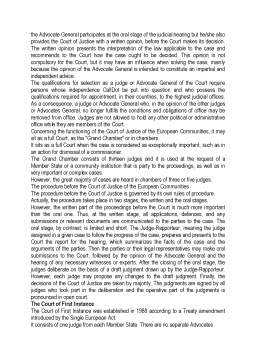Extras din curs
Course 1
12.01.2009
European Union Law
The Creation of the European Communities
After the Second World War in Europe there had been moves towards unification between European states. The first intention was to create a federal entity in Europe as the United States of America but it was not accepted mainly because the federal entity was a way of political integration. Therefore inspiration for the creation of the three organisations known as the European communities came from the plan made in 1950 by Robert Schuman, the French foreign minister, and Jean Monnet, who was responsible for overseeing the French economic recovery after the war.
Thus, on the 9th May 1950 Robert Schuman made a declaration in which he put forward the plan he had worked out with Jean Monnet to pool Europe’s coal and steel industries. This proposal evolved out of the need to reconstruct Europe after the war.
The Schuman plan for the European integration was inspired by the theories of supra-nationality. The plan intended to create a supranational organisation, the community, with institutions capable of making policies and rules which were compulsory for the member states. The feature that was completely new in the Schuman plan and distinguished the community from the usual type of international associations of states was that the member states had transferred some of their rights to the community and had given it powers to act independently. In order to exercise these powers the community was able to issue acts which have the same force as law in individual states.
The Schuman plan had replaced the global integration with integration by sectors of the economy and the political integration with the economic one. Therefore the unification of European Union States had to be accomplished firstly in the economic field.
Afterwards their political integration could be achieved as a result of the solidarity and the common interests of member states. On the basis of the Schuman plan the six founding states namely Belgium, France, Germany, Italy, Luxembourg and the Netherlands had concluded the founding treaty of the European Coal and Steel Community (ECSC).
The treaty was concluded on the 18th of April 1951 in Paris and it entered into force on 23rd July 1952. The treaty of Paris was concluded for 50 years and therefore its duration had expired in 2002. The main objective of the European Coal and Steel Community was to create a common market in the production of coal and steel.
The treaty of Paris had also created four institutions of the European Coal and Steel Community as follows:
1. The High Authority composed of individual personalities and which received the power of making compulsory decisions.
2. The Parliament who was responsible with the political control over the High Authority
3. A Special Council of Ministers who where the representatives of the member states
4. The Code of Justice which was supposed to ensure the application of the Community Law
Afterwards in a new state of the economy with a new development of production and exchanges the six member states of the European Coal and Steel Community had continued the negotiations in 1955 and 1956 in two groups concerning the common market in general and the market of atomic energy. As a consequence the six member states had signed two treaties in Rome on 25th March 1957 creating the European Economic Community and the European Atomic Energy Community (EURATOM). These two communities began their work when the treaties of Rome entered into force on 1st January 1958. The European Economic Community treaty provided the creation of a common market which should cover all the territories of member states and which should have the same features as a national market.
These objectives required the creation of a customs union meaning free internal circulation of merchandise and external protection through a common customs’ taxation. It also required the free circulation of persons, companies, services and capital and the protection of free competition. The European Economic Community treaty also provided the harmonisation of the general economic policies of member states and the establishment of common policies in the field of agriculture, transportation, commercial relations with third countries and so on. Therefore the European Economic Community was concerned with general economic integration achieved by combining the different interests of member states into a common market where goods, persons, services and capital could circulate freely.
The European Atomic Energy Community treaty was based on the idea of an accelerated development of atomic energy; as the European Coal and Steel Community treaty, it covered a limited sector of the economy namely the atomic energy industry.
The two treaties of Rome have also created community institutions for each European community. However, within the two treaties signed in Tome the decision making instance began the council composed of representatives of member states.
Each European community had its own institutions with the exception of the Code of Justice and the Parliament. Thus a convention signed in 1957 and an annex to the treaties of Rome provided that the three European communities had two institutions in common: the Parliament and the Code of Justice.
Preview document
Conținut arhivă zip
- European Union Law.doc


































































